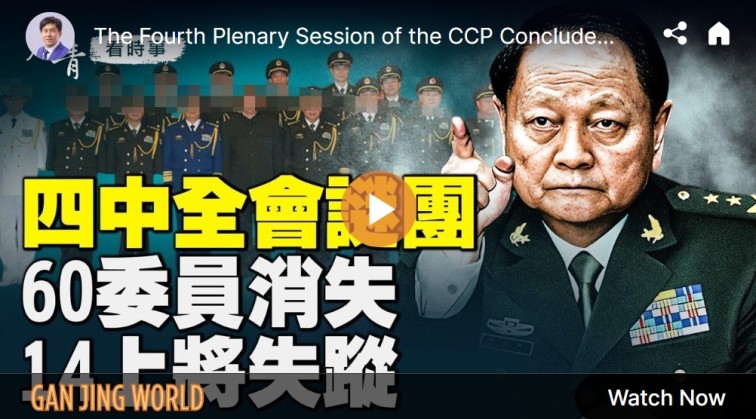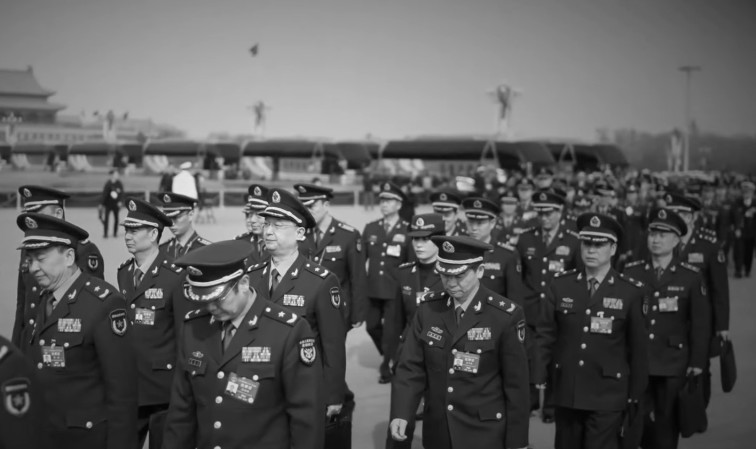The panoramic view of the Forbidden City was covered in smog
[People News] At 5:00 p.m. Beijing time on October 27, 2025, Xinhua News Agency published a report titled “Xi Jinping Visits the Exhibition ‘A Century of Guardianship—From the Forbidden City to the Palace Museum’.” This marked Chinese Communist Party (CCP) leader Xi Jinping’s first public activity following the conclusion of the Fourth Plenary Session.
The report stated that on the morning of October 27, Xi went to the Palace Museum to visit the exhibition “A Century of Guardianship—From the Forbidden City to the Palace Museum.” Cai Qi, member of the CCP Politburo Standing Committee and secretary of the CCP Central Secretariat, also toured the exhibition. Li Shulei and heads of relevant departments of central and state organs participated in the visit.
Compared with similar previous inspection activities, Xi’s visit to the Palace Museum this time exhibited major abnormalities.
First, only two high-ranking officials accompanied Xi—Politburo Standing Committee member Cai Qi and Politburo member Li Shulei. In the past, when Xi attended similar events, he was often accompanied by numerous Politburo Standing Committee members and other vice–national-level officials.
Second, the Xinhua report contained only about 450 words of text and no on-site photos. As of noon on October 28, Beijing time, Xinhua had not updated or added any photographs.
Third, in the CCTV Evening News broadcast on October 27, the footage of Xi visiting the Palace Museum appeared unusually subdued. Both Xi Jinping and Cai Qi looked grim. The segment lasted nearly two minutes, yet most of the footage displayed the exhibition pieces and their introductions. The total screen time showing Xi himself was less than 20 seconds. In previous similar visits, CCP state media usually published numerous on-site photos and videos showing Xi addressing large groups of accompanying officials. This time, no such scenes appeared in the CCTV coverage.
According to reports by Xinhua and CCTV Evening News that same day, Politburo Standing Committee member and Premier Li Qiang attended the 20th East Asia Summit in Kuala Lumpur, Malaysia, on October 27. Politburo Standing Committee member and Chairman of the National People’s Congress Standing Committee Zhao Leji held discussions that afternoon with NPC deputies attending the 18th session of the 14th NPC Standing Committee. Politburo Standing Committee member and Chairman of the Chinese People’s Political Consultative Conference Wang Huning chaired the CPPCC Chairmen’s Meeting in Beijing on the afternoon of October 27.
Aside from Li Qiang, the other four Politburo Standing Committee members—Zhao Leji, Wang Huning, Li Xi, and Ding Xuexiang—should have been in Beijing on the morning of October 27, with no publicly announced activities. Yet none of the four accompanied Xi to the Palace Museum.
Additionally, Xinhua reported that Politburo member and Vice Premier He Lifeng attended and delivered a speech at the opening ceremony of the 2025 Financial Street Forum Annual Conference in Beijing on October 27. Politburo member and Beijing Party Secretary Yin Li also attended the opening ceremony. From October 26 to 27, Central Secretariat Secretary and Minister of Public Security Wang Xiaohong conducted inspections in Guangdong.
He Lifeng and Wang Xiaohong are both longtime Xi loyalists from Fujian and have often been among Xi’s primary companions at public events. In particular, He Lifeng was almost always part of Xi’s entourage during inspection tours. Yet this time, although He was in Beijing that day, he did not accompany Xi to the Palace Museum. Whether this was simply a scheduling conflict or something more remains unknown.
One month earlier, Xi’s trip to Xinjiang had already shown multiple irregularities.
From September 23 to 25, Xi led the CCP Central Delegation to attend the 70th anniversary celebrations of the founding of the Xinjiang Uyghur Autonomous Region but did not deliver a speech. No vice chairmen of the Central Military Commission (CMC) accompanied him throughout the trip. On the afternoon of September 23, Xi met with military officers of colonel rank and above stationed in Ürümqi, yet Xinjiang Military District Commander Lieutenant General Liu Lin and Political Commissar Lieutenant General Yang Cheng were conspicuously absent.
Furthermore, photos and videos published by CCP state media of Xi’s activities in Xinjiang showed a rare scene: Politburo Standing Committee member Wang Huning—widely considered Xi’s close confidant—stood with both hands clasped behind his back while listening to Xi speak. In at least one shot, Standing Committee member Cai Qi and Politburo member He Lifeng, standing behind Wang, also had their hands behind their backs—an attitude starkly different from other officials’ deferential posture.
Wang Huning and others displaying such “disrespectful” body language before Xi was widely interpreted as public contempt or even defiance—an enormous taboo in the CCP’s political culture—drawing external attention and fueling discussions that Xi’s status as the “supreme one” might be eroding.
Since the Third Plenary Session in mid-July 2024, the CCP’s political landscape has undergone sudden changes. Rumors about Xi’s critical illness and even attempted coups have circulated, while his loyal military commanders have fallen one after another. Signs have increasingly pointed to Xi’s power being weakened and his control over the military slipping.
On October 17, 2025, just before the Fourth Plenary Session, the CCP Ministry of National Defense announced that nine top generals—including Vice Chairman of the Central Military Commission He Weidong and former Director of the CMC Political Work Department Miao Hua—had been simultaneously dismissed. Most of the nine hailed from Xi’s core faction, the 31st Group Army, and had been promoted to full generals under Xi’s tenure.
At the recently concluded Fourth Plenary Session, Zhang Shengmin, the head of the CMC Discipline Inspection Commission who oversaw the military purge, was promoted to CMC Vice Chairman, while three CMC member seats remained vacant. Twenty-two full Central Committee members and fourteen alternate members were absent from the session under unusual circumstances. Eight alternate members were not promoted as replacements, including five lieutenant generals—among them Fang Yongxiang, Xi’s chief of staff in the CMC General Office.
Within three days after the Fourth Plenary Session, a series of abnormal developments occurred in the top military ranks, as Xi’s loyalists continued to be purged. On October 25, the CCP Political and Legal Affairs Commission’s website announced that Wang Renhua, Secretary of the CMC Political and Legal Affairs Commission, was no longer serving as a member of the Central Political and Legal Affairs Commission. On October 26, official reports confirmed that Xi’s former chief aide-de-camp, Zhong Shaojun, had been removed from his post as Political Commissar of the National Defense University. (For details, see Li Yanming: “Three Major Abnormalities in the Military Within Three Days After the Fourth Plenary Session.”)
Now, on the fourth day after the Fourth Plenary Session, Xi’s first public appearance since the meeting not only saw a significant reduction in accompanying high-level officials and an unusually subdued scene, but also state media coverage showing remarkable abnormalities and downgrading in tone.
All signs suggest that CCP state media and senior officials in Zhongnanhai appear to be systematically releasing signals of Xi’s declining power—very likely laying the groundwork in public opinion for his potential ouster. Following the Fourth Plenary Session, political turbulence in Zhongnanhai may well accelerate.
(The Dajiyuan)











News magazine bootstrap themes!
I like this themes, fast loading and look profesional
Thank you Carlos!
You're welcome!
Please support me with give positive rating!
Yes Sure!